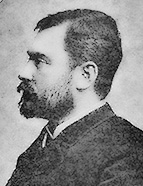

Can it be said, then, that for Oliveira Martins historiography is synonymous with literature? By no means. Perhaps due to an unsatisfactory experience with historical fiction (the now-forgotten Febo Moniz , 1867) and being an avid reader of both national and foreign historians such as Guizot, Michelet, W. Humboldt, Ernest Renan, T. Mommsen, Carlyle, Macaulay, and Lafuente, Martins held a negative view of historical fiction, considering it a pastiche genre. He valued authenticity and the pursuit of truth, grounded in “solidly meticulous knowledge” and “precise and erudite understanding of facts and real conditions, lest, instead of writing history, one invents novels” (“Advertência,” Os filhos de D. João I [The Sons of D. João I], 1891, p. 9). This did not prevent him from being criticised for fantasising about historical facts (Maurício, A invenção… [The Invention...], 2005).
It is nonetheless surprising that one of the most perceptive critiques of his works (and there were many) came from a great fiction writer, his friend Eça de Queiroz. In 1894, in gratitude for receiving A Vida de Nun’Álvares [The Life of Nun’Álvares], Eça remarked on the resemblance between the historical figures depicted in the book and contemporary Portuguese political figures (whom Oliveira Martins knew well): similarities between the Count of Andeiro and the progressive politician Mariano de Carvalho, and between D. Álvaro de Castro and the characteristics of the modern statesman. Eça also objected to particular “plastic detail s ” and asked, using a significant example from A Vida de Nun’Álvares : “What document do you have to state that the queen, at some point , covered Andeiro with kisses, or that the Master pensively ran his hand across his face? … Were you there? Did you see? I think such details do not bring greater intensity of life and create a vague sense of distrust” (Eça de Queiroz, Carta a OM [Letter to OM], 26.04.1894, Correspondência , II, p. 261). In the absence of sources and information gathered from them, the realist process in Martins’s narratives often relied on an effect of verisimilitude. Martins explicitly addressed this psychological method in response to Eça’s criticism: “…man can only be studied in vivo . Nature is not particularly fertile in combinations, and, with the passage of time, types are repeated. The men of any era find their likenesses in the present. Therefore, using the observation of living individuals as a criterion for evaluating those of the past is a method recommended and followed by the masters: Mommsen and Renan. Hence, without his engagement in social and political life or the world of business, it would have been impossible for Oliveira Martins to acquire a “real understanding of men” ( Carta a EQ , s.d. [8-05-1894], Correspondência de Oliveira Martins [Correspondence of Oliveira Martins], p. 266). Moreover, for the historian, a representative personality type seemed to encapsulate the zeitgeist itself—hence his belief that “a well-studied character is worth an entire world observed.” ( Os filhos… , p. 275).
This work is financed by national funds through FCT - Foundation for Science and Technology, I.P, in the scope of the projects UIDB/04311/2020 and UIDP/04311/2020.
